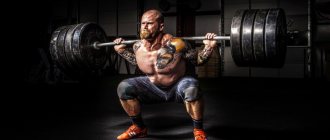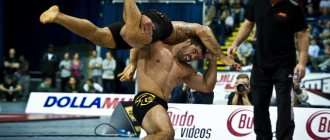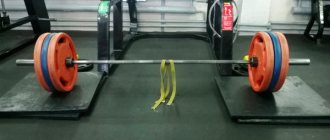Hi guys! Now many of you work out in elite gyms and expensive fitness clubs. This is good! Keep it up! But there are also quite a few people who remember a time when all this did not exist.
When bodybuilders huddled in crowds, they often huddled in cramped gyms somewhere in the basement. This persistent smell of sweat and slightly rusty iron - yes, they remember all this.
In those days and in those circles they knew who Joe Weider was. And those who had a bodybuilding textbook from Vader even knew that there are a lot of bodybuilding training “tricks” that can not only diversify the workout, but also give a powerful impetus to muscle development after their use.
Bodybuilding to this day uses special training principles developed by Joe Weider, the founder of modern bodybuilding. These principles can greatly help an athlete in his progress. These are all important subtleties.
Joe Weider's training principles will be described here for intermediate, experienced and newbies. A beginner in this sense is someone who has already been training for 6-9 months.
If you are still a complete beginner, then you can simply familiarize yourself with these principles and do not rush to apply them until you have completed the initial training in bodybuilding and trained in the initial programs for beginners.
If you are an experienced athlete who has been training for 1 year or more, then this information may be useful to you. By applying these principles, a bodybuilder will diversify his training and take it to a completely different level, a higher level. You will feel the real taste of training and its meaning.
Training principles for beginners
The principle of progressive loading.
This principle is based on constantly increasing the load in your training. Make your muscles work even harder than they are used to.
This is the basic principle for muscle growth and development in bodybuilding. This is the basis of the training. You need to increase not only the weight of the equipment, but also the number of approaches in the exercise. To train muscular endurance and work on muscle definition, you need to reduce the rest time between approaches.
The principle of shock.
The basis of this principle is to constantly surprise your muscles. Your body should not get used to monotonous workouts. You need to change exercises, angles of impact on muscles, number of approaches, repetitions. When you do this, then each time your muscles will experience stress, which will stimulate the growth of new muscle tissue.
The principle of isolation.
To develop a specific muscle, you need to try to “isolate” it as much as possible. All this is achieved by changing the anatomical position of the body during the exercise.
If you want to isolate your biceps, perform curls while sitting on a curling device or standing against a wall with your elbows touching the wall. Then you will not be able to help yourself lift the barbell by swinging and using your back. You isolate your biceps.
Forced reps
One of the most popular methods for building muscle mass. A special technique of performing exercises is used, in which the muscles receive maximum stress. To train this type you need to have the help of a partner. The main thing to understand is that assistance should be provided at the peak of amplitude, when the athlete himself is no longer able to perform the repetition technically correctly.
Forced reps are a method that allows you to push past the point of failure and obtain maximum muscle response. This stimulates the body to supercompensate. It is important to consider that in this case the emotional approach is very important, you must be charged, tuned and ready, otherwise there is no point and there will be no effect.
This method is suitable mainly for basic exercises. Of course, you can use it in other variations, but most often this is impractical and sometimes unsafe.
Based on the fact that forced exercises are done once a month or once every two months, the process should be of the nature of a maximum load:
1) Do 2-3 approaches until complete fatigue; the partner should not participate in these repetitions.
2) Then, at the moment when you yourself can no longer technically perform the exercise, your partner should “help” you, but not take on the entire load, but only help maintain a high amplitude.
3) At this moment you cross the border of “refusal”. In this state, you need to perform 2-3 more forced repetitions.
This method is very effective, since it increases the secretion of growth hormone by 300%, which has been proven by scientific research. It is necessary to take into account the effect of forced training on the nervous system and the risk of overtraining, so this method should not be abused. Rest between sets should last at least 4 minutes.
Joe Weider's Training Principles for Intermediate Athletes
The principle of priority.
The whole secret here is to train your weakest muscle first, while your strength is at its highest level. Due to the fact that you will work this muscle more intensely than in the middle of the workout or at the end, you will stimulate its development as much as possible.
The pyramid principle.
It is known that muscles grow under the influence of powerful weights. But if you train with such weights from the very beginning of your training, without proper preparation, this can lead to injury.
The pyramid system helps get around this problem. Start your workout with a weight of 60% of your maximum and do 15 repetitions. Then increase the weight a little and perform 10-12 reps. Gradually increase the weight to 80% of the maximum and perform 5-6 repetitions. Now you can work with heavy weights without fear of injury.
Super series principle.
Following this training principle, you need to perform 2 sets in a row for the antagonist muscles. Antagonist muscles are those that are opposite in their functions. For example, biceps (flexion of the arm) and triceps (extension of the arm), chest (press from oneself) and back (pulling towards oneself), quadriceps (extends the leg) and biceps of the thigh (bends the leg).
By performing super series you contribute to better recovery of your muscles. How? This is due to nerve pulsation. For example, after a set for triceps (after a set for biceps), recovery of the biceps is accelerated. This principle is an excellent tool for muscle pumping and recovery.
The principle of integrated approaches.
Using this principle, you need to perform 2 exercises in a row on the same muscle. For example, bench press and dumbbell flyes.
Thus, you are not trying to restore the muscle, but rather “kill” it in order to stimulate its stress and future growth. Don't confuse super series and combined approaches. Super series are 2 sets in a row for 2 different muscles, and a combined set is 2 sets for the same muscle.
Construction of training cycles.
You can read more about this here. The main point is that throughout the year you will need to change the direction of the training program.
At some period of time you will need to work on the mass, and in another period you will work on the relief. This will add variety to your workouts, help avoid injury, and stabilize your bodybuilding success.
The principle of integrity.
Simply put, our muscles contain different systems and protein structures that respond differently to training.
Certain muscle tissues grow well when we lift heavy weights for low reps, like 4-6 (anaerobic exercises).
Other tissues respond to endurance training (aerobic exercise). Therefore, in order to develop fully and efficiently, you need to plan your training in a variety of ways and perform both small and large numbers of repetitions.
The principle of “Approaches (sets)”
Any exercise must be done in a certain number of sets. Sometimes you can underestimate the load or, conversely, exaggerate it. The most optimal amount for rapid muscle growth is 2 to 4 working approaches in one simple exercise. Sometimes warm-up sets with minimal weight are added to them. For a muscle group in bodybuilding, 2-4 exercises are used, respectively, from 4 to 16 sets per workout. This is written down as follows: bench press 4X6 - 8. That is, 4 sets of 6-8 repetitions. That's math!
Principle "Growth"
The most important thing is desire. With the help of such an incredible tool as bodybuilding, you can get an amazing body. Build a mountain of muscle, or maybe just pump up a little? Everything will work out if you have the desire and perseverance to achieve your goal. You are not yet familiar with the unique capabilities of your body. When looking at professional athletes, remember that they were once in your shoes. There was a lot they didn’t know how to do, they didn’t know, they were afraid. We started with light weights and gradually increased the load. But today they are at the top of the podium. So take a step towards them! Constantly grow, don't stand still! Change your body for the better!
THE MAIN PRINCIPLE OF BODYBUILDING (body building) The basis of everything!
Igor February 1, 2011
Sources[edit | edit code]
- Hohmann A., Lames M., Letzelter M. Einfuhrung in die Trainingswissenschaft. Wiebelsheim: Limpert, 2007.
- ↑ 2,02,1 Grosser M., Starischka S. Das neue Konditionstraining fur alle Sportarten, fur Kinder, Jugendliche und Aktive. Munchen: BLV, 1998.
- ↑ 3,03,13,23,33,4 Weineck J. Optimales Training—Leistungsphysiologische Trainingslehre unter besonderer Berucksichtigung des Kinderund Jugendtrainings. Balingen: Spitta, 2007.
- ↑ 4,04,1 Martin D., Carl K., Lehnertz K. Handbuch Trainingslehre. Schorndorf: Hofmann, 2001.
- ↑ 5.05.1 Schollhorn WI, Beckmann H., MichelbrinkM. System(at) ische Betrachtung von Trainingsprinzipien. In: Burger R., Augustin D., MullerN. et al. (Hrsg.). Trainings-wissenschaft—Facetten in Lehre und Forschung. Nie-dernhausen: Schors, 2005.
- ↑ 6.06.1 Letzelter M. Trainingsgrundlagen. Reinbek: Rowohlt, 1997.
- ↑ 7,07,17,2 Steinhofer D. Grundlagen des Athletictrainings. Munster: Philippka: 2003.
- Zatsiorsky VM, Kraemer WJ Krafttraining. Praxis und Wissenschaft. Aachen: Meyer & Meyer, 2008.
- Mester J., Perl J. Grenzen der Anpassungs- und Leistungs-fahigkeit aus systemischer Sicht—Zeitreihenanalyse und ein informatisches Metamodell zur Untersuchung physiologischer Adaptationsprozesse. Leistungsport. 2000; 30(1): 43-51.
- Perl J., Mester J. Modellgestutzte Analyse und Optimierung der Wechselwirkung zwischen Belastung und Leistung. Leistungsport. 2001; 31(2): 54-62.
- Matveev L.P. (1964). The problem of periodization of sports training. M.: Physical education and sports.
- Matveev L.P. (1981). Basics of sports training. M.: Progress.
Down with bellies!
Nowadays, it is too common to see bodybuilders on stage with bulging bellies and a lack of aesthetic lines in the waist area.
Let's turn to the representatives of the era of the 80s of the last century - Lee Haney and Mike Christian, the giants of that time, as well as to their direct rivals in the 90s, Flex Wheeler and Shawn Ray.
These guys are a clear example of well-packed muscle mass in compliance with the principle of classical proportionality. It is the middle part of the body that serves as a marker of an aesthetically balanced physique. This is the central part of the athlete's entire figure. Every pose from any angle starts from the center of the body. A narrow waist makes the shoulders and back visually wider, the chest fuller, and the legs massive.
In the old days, a stretched midsection was a rarity because the abs were given as much attention as other parts of the body. Work your abs every workout using different types of crunches and leg raises.
Often, too dynamic a set of large mass leads to inflation of the middle sector, which is subsequently extremely difficult to correct.
Peak contraction principle
Peak contraction is a technique by which you maintain the maximum tension of the working muscle while it is in a fully contracted state. For example, when you curl your arms with dumbbells, you usually lose the feeling of resistance at the top of the movement when you “turn off” the arm with the weight. To get rid of this loss and ensure that resistance is applied to the fully contracted muscle, lean forward at the end of the exercise so that the arm will never be able to completely “switch off.”
The principle of instinctive training
This is the only universal rule in athletics. Only you can know which exercises work best for your body. Gradually, all athletes should achieve the ability to create programs, exercise groups, sets and repetitions that work best for them. If they didn't do this, they would never reach their full potential. Each person responds differently to different diets and exercise regimens. As you gain experience, you will instinctively know how to practice for best results. Remember: you are unique and should train with that in mind!









